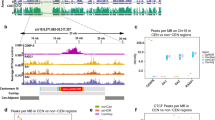Summary
A supernumerary microchromosome measuring 0.5–1 μm found in over half of the metaphases of a CREST scleroderma patient and his daughter has been characterized by various cytogenetic techniques. The microchromosome consisted of constitutive heterochromatin and contained nuclear antigens reacting with specific anti-kinetochore antibodies. The most remarkable property of the microchromosome was its non-random position: it was closely associated with the centromere of any of the normal chromosomes in the majority of the metaphases. Furthermore, an inordinately high rate of Y chromosome aneuploidy was found in the CREST scleroderma patient. The origin and structure of the microchromosome, its possible connection with the CREST variant of scleroderma, and the phenomenon of centromeric association are discussed.
Similar content being viewed by others
References
Bennett MD (1983) The spatial distribution of chromosomes. In: Brandham P, Bennett MD (eds) Proceedings 2nd Kew Chromosome Conference. Allen and Unwin, London, pp 71–79
Buckton KE, Spowart G, Newton MS, Evans HJ (1985) Forty-four probands with an additional “marker” chromosome. Hum Genet 69:353–370
Caspersson T, Zech L, Johannson C, Modest EJ (1970) Identification of human chromosomes by DNA-binding fluorescent agents. Chromosoma 30:215–277
Chiarelli B, Brøgger A (1978) Superchromosomal organization and its cytogenetic consequences in the Eukaryota. Genetica 49:109–126
Comings DE (1980) Arrangement of chromatin in the nucleus. Hum Genet 53:131–143
Flavell RB (1985) The spatial distribution of chromosomes in the nucleus. Bioessays 2:78–80
Fritzler MJ, Kinsella TD (1980) The CREST syndrome: a distinct serologic entity with anticentromere antibodies. Am J Med 69:520–526
Goodpasture C, Bloom SE (1975) Visualization of nucleolar organizer regions in mammalian chromosomes using silver staining. Chromosoma 53:37–50
Haaf T, Schmid M (1988) Analysis of double minutes and double minute-like chromatin in human and murine tumor cells using antikinetochore antibodies. Cancer Genet Cytogenet 30:73–82
Hubert J, Bourgeois CA (1986) The nuclear skeleton and the spatial arrangement of chromosomes in the interphase nucleus of vertebrate somatic cells. Hum Genet 74:1–15
Kistenmacher ML, Punnett HH (1970) Comparative behavior of ring chromosomes. Am J Hum Genet 22:304–318
Lubs H, Hostetter T, Ewing L (1972) Cited in Paris Conference Standardization in human cytogenetics. Birth Defects 8:42
Maraschio P, Zuffardi O, Bernardi F, Bozzola M, Paoli C de, Fonatsch C, Flatz SD, Ghersini L, Ginelli G, Loi M, Lorini R, Peretti D, Poloni L, Tonetti D, Vanni R, Zamboni G (1981) Preferential maternal derivation in inv dup (15). Analysis of eight new cases. Hum Genet 57:345–350
Merry DE, Pathak S, Hsu TC, Brinkley BR (1985) Anti-kinetochore antibodies: use as probes for inactive centromeres. Am J Hum Genet 37:425–430
Moroi Y, Peebles C, Fritzler M, Steigerwald J, Tan EM (1980) Auto-antibody to centromere (kinetochore) in seleroderma sera. Proc Natl Acad Sci USA 77:1627–1631
Münke M, Martinville B de, Lieber E, Francke U (1985) Minute chromosomes replacing the Y chromosome carry Y-specific sequences by restriction fragment analysis and in situ hybridization. Am J Med Genet 22:361–374
Neitzel H (1986) A routine method for the establishment of permanent growing lymphoblastoid cell lines. Hum Genet 73:320–326
Northway JD, Tan EM (1972) Differentiation of antinuclear antibodies giving speckled patterns in immunofluorescence. Clin Immunol Immunopathol 1:140–147
Pathak S, Sinha AK (1972) An alternative model for ring chromosome perpetuation in a human subject. Ann Hum Genet 35:471–476
Patil SR, Waziri M (1982) “Hitch-hiking” chromatin material of unknown origin. Am J Hum Genet 34:137A
Rodman TC, Flehinger BJ, Rohlf FJ (1980) Metaphase chromosome associations: colcemid distorts the pattern. Cytogenet Cell Genet 27:98–110
Rodnan GP, Medsger TA, Buckingham RB (1975) Progressive systemic sclerosis-CREST-syndrome: observations on natural history and late complications in 90 patients. Arthritis Rheum 18:423–431
Schinzel A, Schmid W, Fraccaro M, Tiepolo L, Zuffardi O, Opitz JM, Lindsten J, Zetterqvist P, Enell H, Baccichetti C, Tenconi R, Pagon RA (1981) The “cat eye syndrome”: dicentric small marker chromosome probably derived from a no. 22 (tetrasomy 22pter → q11) associated with characteristic phenotype. Report of 11 patients and delineation of the clinical picture. Hum Genet 57:148–158
Schmid M (1980) Chromosome banding in Amphibia. IV. Differentiation of GC- and AT-rich chromosome regions in Anura. Chromosoma 77:83–103
Schmid M (1985) Arrangement of the Y chromosome in interphase and metaphase cells. In: Sandberg AA (ed) The Y chromosome, part A: Basic characteristics of the Y chromosome. (Progress and topics in cytogenetics, vol 6) Liss, New York, pp 17–61
Schwarzacher HG, Wolf U (eds) (1974) Methods in human cytogenetics. Springer, Berlin Heidelberg New York
Schweizer D, Ambros P, Andrle M (1978) Modification of DAPI banding on human chromosomes by prestaining with a DNA-binding oligopeptide antibiotic, distamycin A. Exp Cell Res 111:327–332
Sehested J (1974) A simple method for R-banding of human chromosomes, showing a pH-dependent connection between R and G bands. Hum Genet 21:55–58
Sumner AT (1972) A simple technique for demonstrating centromeric heterochromatin. Exp Cell Res 75:304–306
Tan EM, Rodnan GP, Garcia I, Moroi Y, Fritzler M, Peebles C (1980) Diversity of antinuclear antibodies in progressive systemic sclerosis. Anti-centromere antibody and its relationship to CREST syndrome. Arthritis Rheum 23:617–625
Viegas-Péquignot E, Dutrillaux B (1978) Une méthode simple pour obtenir des prophases et des prométaphases. Ann Génét (Paris) 21:122–125
Author information
Authors and Affiliations
Rights and permissions
About this article
Cite this article
Schmid, M., Haaf, T., Schindler, D. et al. Centromeric association of a microchromosome. Hum Genet 81, 127–136 (1989). https://doi.org/10.1007/BF00293888
Received:
Revised:
Issue Date:
DOI: https://doi.org/10.1007/BF00293888




